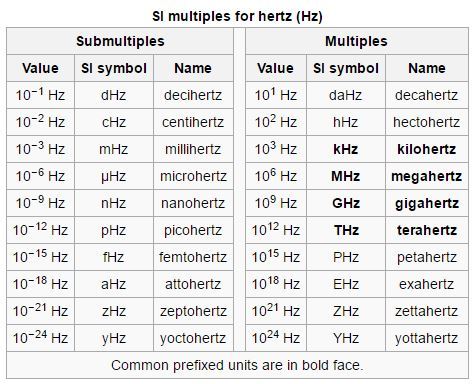Difference between revisions of "User:0864867/Week 3"
| Line 9: | Line 9: | ||
Hertz is the amount of oscilation per second, it is the unit of frequency. The name comes from Heinrich Rudolf Hertz, he was the first one to provide proof of the existence of electromagnetic waves at around 1865. At around 1960 it was made official by the CGPM that frequency was now called Hertz. Before this frequency was expressed as ‘cycles per second’, such as ‘kilocycles’ & ‘megacycles’. | Hertz is the amount of oscilation per second, it is the unit of frequency. The name comes from Heinrich Rudolf Hertz, he was the first one to provide proof of the existence of electromagnetic waves at around 1865. At around 1960 it was made official by the CGPM that frequency was now called Hertz. Before this frequency was expressed as ‘cycles per second’, such as ‘kilocycles’ & ‘megacycles’. | ||
| − | [[File:0864867_week3_radiation_hertz.gif|600px|left]] | + | [[File:0864867_week3_radiation_hertz.gif|600px|left]] [[File:0864867_week3_radiation_Multiples.JPG|500px|right]] |
In the illustration above you can see how Hertz work. 1 Hz is 1 oscilation per second, 5 Hz is five oscilations per second, and so on. | In the illustration above you can see how Hertz work. 1 Hz is 1 oscilation per second, 5 Hz is five oscilations per second, and so on. | ||
| Line 19: | Line 19: | ||
Etc. | Etc. | ||
| − | Radiations like long-wave infrared light is mostly defined by terahertz radiation. Higher frequencies like Gamma-rays is mostly measured in exahertz. | + | Radiations like long-wave infrared light is mostly defined by terahertz radiation. Higher frequencies like Gamma-rays is mostly measured in exahertz. |
| − | |||
| − | |||
| − | |||
| − | |||
==RTL-SDR== | ==RTL-SDR== | ||
Revision as of 16:50, 30 October 2016
Quarter 9 is all about introductions about the topic Radiation and all of this information is found here.
Radiation
I did a research on understanding Radiation in forms of AM/FM and Hertz You can read it here:
▪ WHAT ARE HERTZ?
Hertz is the amount of oscilation per second, it is the unit of frequency. The name comes from Heinrich Rudolf Hertz, he was the first one to provide proof of the existence of electromagnetic waves at around 1865. At around 1960 it was made official by the CGPM that frequency was now called Hertz. Before this frequency was expressed as ‘cycles per second’, such as ‘kilocycles’ & ‘megacycles’.
In the illustration above you can see how Hertz work. 1 Hz is 1 oscilation per second, 5 Hz is five oscilations per second, and so on.
Hertz has many multiples. Radiowaves are mostly expressed in kHz, MHz or GHz. 1000 Hz = 1 kHz 1000 kHz = 1 MHz 1000 MHz = 1 GHz Etc.
Radiations like long-wave infrared light is mostly defined by terahertz radiation. Higher frequencies like Gamma-rays is mostly measured in exahertz.

